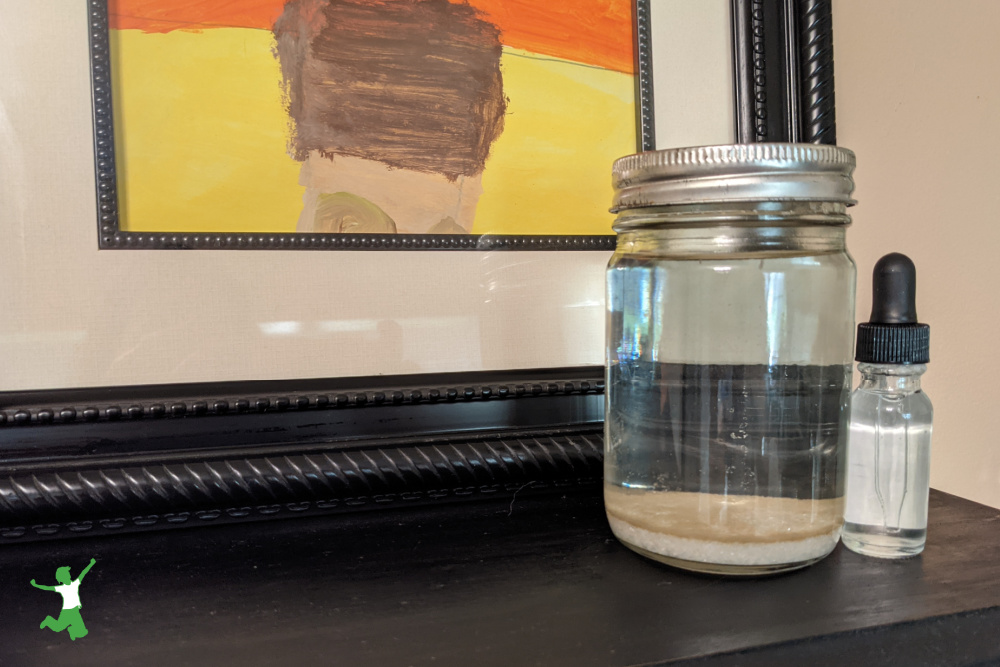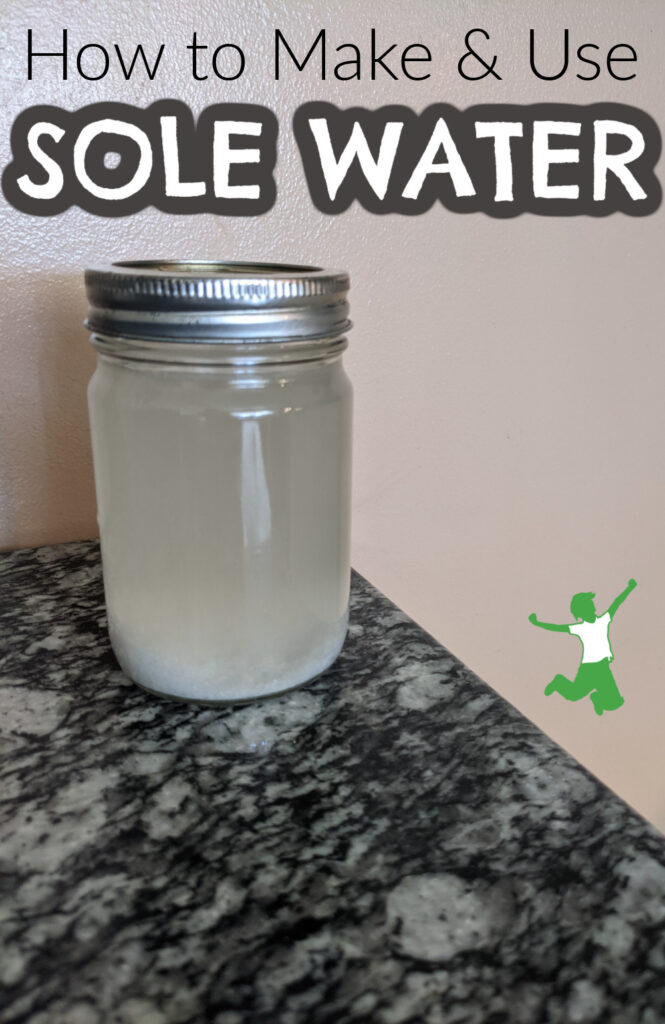How to make and use solé water, a super saturated salt solution that is a safe, easily absorbed colloidal supplement to ensure your body is getting sufficient ionic minerals for optimal function.

My post on the dangers of low salt diets (and why you should RUN if a doctor ever suggests one) resulted in a number of you reaching out about how to know whether you are getting sufficient good salt every day for optimal function.
As a result, I thought I would share my method for making solé (pronounced Sol-ay) water, a highly saturated solution that you make with filtered water and a mineral-rich raw sea salt.
You perhaps already are familiar with super saturated potassium iodide (SSKI) which is great for loosening congestion and as an expectorant. It’s a country doctor remedy my Dad used for decades in his practice.
Well, solé is simply a different natural remedy made from a mineral solution in water. It is used in droplet form in a similar fashion.
And, while many sources use pink Himalayan salt to make it, I recommend that you don’t as it’s not the best one to use. More on this below…
Solé Water Benefits
The benefits of solé solution are enormous in my personal experience including:
- Increased energy
- Better sleep
- More endurance when exercising
- Improved mental clarity and focus
- Greatly reduced sensitivity to heat (a big one for me in the summer!)
- Reduction/elimination of painful muscle cramping issues
There are many other benefits as well. (1)
I just list the ones above, as those are the ones I’ve personally noticed.
What Type of Sea Salt?
While most sources suggest making solé with Himalayan pink sea salt, I prefer to make it with this type of coarse gray salt which is tested for purity and is higher in minerals than any other. It is also tested free of microplastics.
Most people do not realize that Himalayan pink salt doesn’t even come from the Himalayas!
It is mined in Pakistan from many different mines involving a great variation in mineral composition (85-99% sodium chloride).
Thus, if you use pink Himalaya sea salt, you really have no idea what you are getting. (2)
By comparison, this sea salt from the Sea of Cortez in North America is consistently measured at 72% sodium (NaCl). (2)
Even Celtic sea salt is shockingly high by comparison at 88.5% sodium chloride. (2)
Redmond Real Salt is 98% sodium chloride, only 1% less than white refined table salt. (2)
Why is Lower Sodium Content A Good Thing?
Having a lower sodium content means there are MORE minerals. This includes over 90 minerals and trace elements for raw salt from the Sea of Cortez.
This is important not because sodium is “bad”. Again, less sodium in a sea salt simply means MORE minerals and trace elements.
Nutritional deficiency in some of these critical trace minerals that people simply do not get…EVER…even on a whole food diet can contribute to issues with lack of energy and propensity for disease.
While the major minerals such as magnesium, potassium, calcium, etc are a big focus for supplement companies, it’s the trace minerals that can make a huge impact once you get them into your diet.
And, a colloidal solution of mineral-rich ions from sea salt is not only highly absorbable but also the most cost-effective manner for accomplishing this!
How Solé Solution is Made
When purified water and raw mineralized sea salt come into contact, a new geometric structure is formed via a gentle chemical reaction.
This is what solé is by definition.
Negative poles in water molecules attract positive mineralized salt ions.
In addition, negative mineralized salt ions attach to positive polarized particles of water molecules.
Once this chemical reaction occurs, solé becomes molecularly different from its original components of plain water and sea salt.
The major minerals and trace elements, including magnesium, calcium, boron, selenium and sulfur, separate into ions in the water, releasing stored energy to form new molecular bonds with a higher energy level.
When you ingest small amounts of solé, these ions are in colloidal form and easily absorbed with little to no effort from the body.
An interesting factoid is that the amniotic fluid which keeps babies safe in their mother’s womb is solé too!
Making Solé at Home
The best way to enjoy the benefits of an authentic solé solution is to make it yourself.
All that is required is a small glass jar with a lid, a few tablespoons of mineral-rich sea salt (this one is the best by far), and filtered water.
Easy Steps
Here are the simple steps!
- Fill a small half-pint glass jar one-quarter full with mineral-rich sea salt.
- Add filtered water to just below the rim of the jar.
- Close the lid tightly and turn the jar several times to thoroughly mix the salt with the water.
- Place jar on the counter for 24 hours.
- After one day has passed, if there is still some salt in the bottom of the jar, the water portion is now solé! You can use it as is or transfer some of the water into a smaller bottle with an eyedropper to keep by your bedside (for use first thing in the morning and before bed).
- If all the salt is gone, add another tablespoon or two and repeat steps #3 and #4 until a small amount of salt remains at the bottom of the jar.
That’s all there is to it!
How to Use
There are two ways to use solé on a daily basis.
Under the Tongue
First, you can use an eyedropper and drip 5-10 drops under the tongue first thing in the morning and just before bed.
This is the “homeopathic-style” method I use as I love the mildly salty taste and can leave the drops in the mouth for a minute or so before swallowing.
This allows maximum absorption of the ions straight into the bloodstream from the very thin gum tissues.
Teaspoon in a Glass of Water
The second way to use solé is to stir one teaspoon into a glass of water and drink it immediately. This is the method most people use.
Whichever method suits you best, use that one!
The important thing is to do this daily for best results.
How Much Sodium in Solé?
One teaspoon of solé made with sea salt from the Sea of Cortez (my strong recommendation) contains 478 mg of sodium.
This is roughly 20% of the USDA’s recommended daily allowance of 2,300 mg (1 tsp per day).
Note that the USDA RDA for sodium is way too low. This level is actually harmful to the vast majority of people.
According to the Weston Price Foundation, humans need at least one and one-half teaspoons of salt per day (roughly 3500 mg), and some do better on double that amount. (3)
Thus, solé is not only a great way to ensure you are getting plenty of ionic trace minerals, it is a good way to make sure you are taking in enough sodium for optimal health too.

(1) Sole: The Ultimate Guide
(2) Which Salt Has the Most Minerals?
(3) Targeting Salt








How long does a batch last and how should it be stored?
I keep mine in a glass bottle on the nightstand so I can use first thing in the morning and just before bed. It doesn’t go off as it is just highly saturated salt water, which is naturally preserved.
Thanks for the info on how to make Sole. I was excited to try the high mineral salt you recommended, Baja Gold. But their website says it had 219 ppb of lead last time it was tested in 2019. I would love to know if you think that’s safe or if you have found a cleaner high mineral salt.
This is an article I wrote recently on the truth about lead in sea salt. https://www.thehealthyhomeeconomist.com/truth-about-lead-sea-salt/
The amount of lead in Baja Gold is miniscule and far less than what the EPA allows and says is safe for playground soil!
You mentioned using filtered water in the recipe, what about distilled water?
Distilled water is not a healthy choice and is only appropriate for a neti pot or other medicinal use.
Hello!
About how long do you have to finish the jar after it’s made? Roughly how long will it last till it shouldn’t be used?
If I use sole with the dropper method, do I still need to re-mineralize my reverse osmosis drinking water? Or should I use the salt for both?
Is there a particular salt shaker you like to use? Lately, my options are giving too much or too little. Frustrating.
I don’t use salt shakers myself. I have a grinder and that’s it.